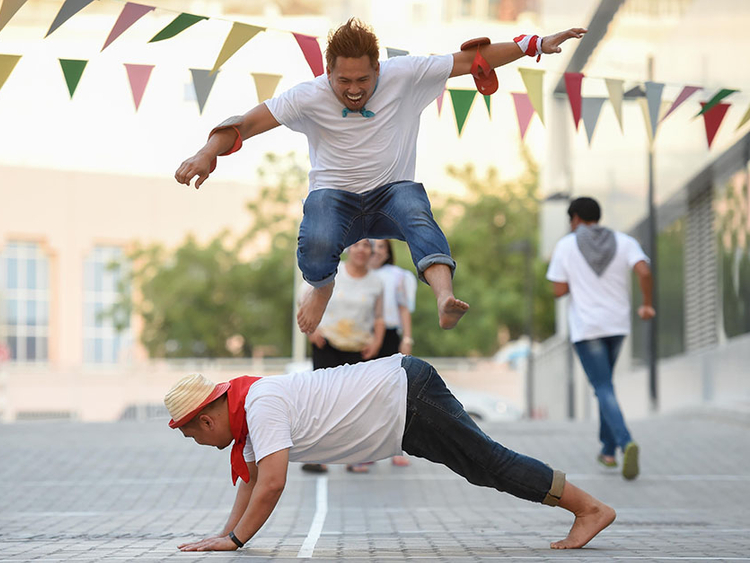Dubai: Before online gaming and Playstations came along to challenge the dexterity of our thumbs, there were the physically challenging but fun outdoor games.
For Filipinos, traditional games presented chances to make more friends, and have a lot of fun. The beloved games have their own regional names, too: Patintero or Tubig-Tubig, Tumbang Preso or Bato Lata and so much more.
Have these games been lost with the rise of a generation of smartphone lovers?
Video by Jobannie Tabada/Irish Eden Belleza
Reintroducing tradition
A group of expatriates are planning to reintroduce traditional Philippine games to Filipino expats in the UAE and introduce them to the rest of the world with the sports event Palarong Pinoy on July 20 at the Dubai Sports World, which features classics such as patintero and tumbang preso.
Ericson Reyes, president of the #Fun group that is organising the event, promises it will be a “family fun-filled day to bring back the fun of traditional Filipino games”, which features classics such as patintero, tumbang preso, and something completely new: “our own version of Pinoy Sky Dive”.
For the love of marbles
Sharjah-based architect and online radio jockey Jason Roi Bucton will no doubt be sharing his love of marbles to his sons. He fondly remembers playing the game with his dad.
The 37-year-old says it will remain his favourite, although he also loved playing dampa, a game played rubber bands. “I used to play jolen (marbles) and dampa with my cousins in my grandmother’s courtyard. We didn’t even care about the dirt or the germs,” he said.
He said his marble collection grew to about a hundred, and that he used to wash them “to make them shiny”.
How to play jolen
The objective of this game is to collect the most marbles, Bucton says. He explains how the game is played:
1. Draw a circle on the ground, and a starting line (this can be as far away as two metres).
2. A game of rock, papers, scissors determines who gets to play first in a two-person game. Multiple players must shoot a marble into a circle drawn on the ground. The closer a player can shoot his marble to the circle, the more he moves up in the order of play.
3. Each player must agree on an equal number of marbles to be placed inside the circle.
4. Taking turns from the starting line, players must use their marble to hit marbles in the circle. The player wins the marbles that roll out of the circle.
5. The game continues until all marbles are won.
Patintero: A game of tag
No doubt the game patintero, or tubig-tubig as it is known in other parts of the Philippines, is one of the most widely-played traditional games.

Dubai-based analyst Sharon Parilla, 41, says she used to play it regularly as a child, along with games like tumbang preso, a game played by hitting an empty tin can with a slipper.
“At school, [my classmate] would stand next to the door and wait for the bell to ring to save the spot we used in playing patintero,” Parilla says. She prefers playing the game “because it requires teamwork”.
"I would love to see children raised in Dubai fast in running in patintero and aiming sharply in tumbang preso," Parilla says.
Cecilia Leoparte, 58, a government affairs manager, says that as a child she used to play with children from her neighbourhood. “It was really fun especially if you win or if your team wins. I remember always looking forward to each day to play these games,” Leoparte says.
Angie Lozada, 52, a payroll specialist, says patintero was one of the games she loved playing as a child, along with tumbang preso, syatong, Chinese garter and tago-taguan.
“The last time I played these games was in the 1970s. I used to play with my siblings and neighbours. I remembered those days: we were all looking forward to go to the plaza after dinner especially during the full moon. We start to play from 7pm until early morning, usually if the full moon falls on weekends,” she says.
How to play patintero
Two teams of up to eight people can play this game, say Lozada. She explains how the game is played:
1. Draw a rectangle on the ground, with two horizontal lines and one long vertical line at the centre to create six squares.
2. Assign four players to guard each horizontal line and vertical line.
3. The objective of the game is for all players to cross the three horizontal lines and back to the starting line without being tagged by any of the guards from the opposing team.
4. Any player who is tagged is disqualified from the game.
5. The team whose player manages to cross all horizontal lines and back to the starting line without being tagged wins the game.
Tumbang preso
Got an empty tin can and a pair of slippers? Put your game face on and you’re set to play tumbang preso!

Alvan Matiga, 45, a Dubai-based logistic assistant, says he used to play the game as a child, along with patintero, luksong tinik or syatong.
“I last played tumbang preso in the 1990s. One of my fondest memories in life was playing tumbang preso with my cousins and neighbours. We played under the sun; hands all dirty and bodies all sweaty, but nothing compares to the enjoyment we got from those days,” he says.
“Playing traditional games can increase you social skills and expose you to new things that you may not learn in class. It helps the children improve their thinking skills and create strategies to win the game,” he says.
How to play tumbang preso
Tumbang preso, or tumba lata as it is known in other parts of the Philippines, means "knock down the prisoner". The game can be played by up to ten players, including the guard. One versus many. Matiga explains how the game is played:
1. Draw a circle on the ground and put an empty tin can inside the circle. This should be guarded by one player.
2. The rest of the players will have to stand behind the starting line several metres away.
3. Players should hit or knock down the can with their slipper and retrieve the slipper without being tagged as they go back to the starting line. Whoever is tagged becomes the next guard.
4. The guard must make sure that the can is back in the circle if it gets hit, and tag other players once they leave the starting line.
5. If a player is not able to retrieve his or her slipper, others can save the player by hitting the can out of the circle.
6. When all players run out of slippers, the game turns into a chase. Players must need to retrieve their slippers without being tagged as they had back to the starting line.
Here are two more traditional Filipino games you can have tons of fun playing outdoors:
Luksong tinik
The game literally means jumping over thorns. This game will test your agility and dexterity. The game is played by two teams.

1. Team leaders will need to sit on the ground as human hurdles. They will need to use their feet and hands to set the bar higher, so to speak.
2. Players will need to jump over the hurdle.
3. The hurdle increases in difficulty with team leaders moving from connecting the sole of their feet to piling on their feet and hands to increase the height of each hurdle that players must jump over.
4. A player whose body part touches over any of the leaders' body parts is eliminated from the game.
Luksong baka
The game literally means "jump over the cow" and is almost similar to luksong tinik. The game can be played by up to 10 players.

Here is how it is played:
1. The goal is to jump over the "it" player called the baka.
2. The "it player" starts starts in a kneeling position.
3. Players must jump over the "it" player without any of their body part touching the player.
4. The game progresses as the "it" player uses his body to raise the hurdle and make the jump harder.
















